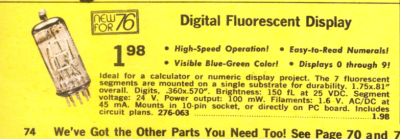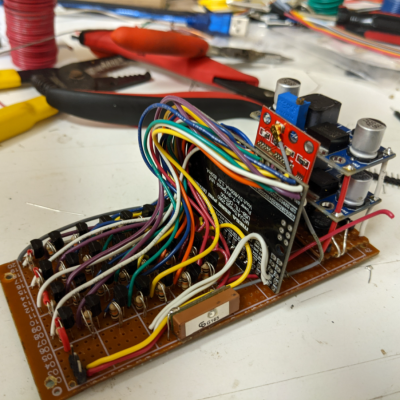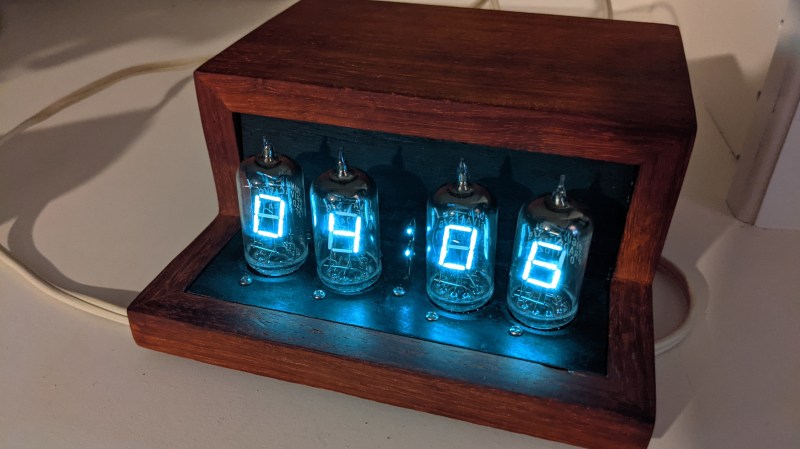
When you have a small stock of vacuum fluorescent displays (VFDs) straight out of the 1976 Radio Shack catalog, you might sit around wondering what to do with them. When [stepawayfromthegirls] found out that his stash of seven DT-1704A tubes may be the last in existence, there was no question. They must be displayed! [stepawayfromthegirls]’ mode of display is this captivating clock build. Four VFDs with their aqua colored elements are set against a black background in a bespoke wooden case. Looking under the hood, the beauty only increases.

Keeping the build organized was not an easy task because the tubes are designed in such a way that each segment must be individually controlled. The needed I/O duties are provided by an Arduino Mega 2560 Pro (Embed). 28 2n3904’s each with their two resistors serve as drivers for each VFD segment.
The output of a 24 V AC transformer left over from the 1980s is rectified to 34 V of DC power which is then regulated to 27 V to power the tubes. Switching power supplies provide 6 V to the Arduino and 1.3 V to the filaments. If you look closely, you’ll also see a GPS module so that the clock doesn’t need to be set. To future-proof the clock against daylight savings time adjustments, a potentiometer on the back of the case allows the user to set custom hour offsets without editing any code.
We think the end result is a remarkably clean, simple, and elegant clock that he will be proud of for many years to come!
If VFD clock builds are your thing, then you’ll enjoy this Network Attached VFD Clock and a Mini VFD Clock with floating display. And while not VFD based, we’d be silly to leave out the Boat Anchor Nixie Clock with enough knobs, switches, and buttons to delight even the fussiest of hacker.
















Those Radio Shack (Tandy in the UK) catalogs always made me laugh! They were always liberally peppered! With exclamation marks! And spoke like Shatner!
Were they selling clock ICs at the time?
My recollection is that they often carried neat and exotic parts, but not everything you needed. When build your own satellite tv receivers were big, they carried some parts you really needed, but not everything (or maybe nobody would want to oay their prices for all the parts).
I remember one computer magazine that used exclamation points so much, I was tempted to write a letter to them on the topic.
Nice build ! As kid I built a VFD clock using perf board and push pins. It was built around a CT-7001 clock/calendar chip which was hightech for it’s time. Sadly the clock was nearly crushed in a move. I saved the chip and later put it in a Tandy 2 board LED kit. I recently found it buried in storage and am doing a restoring it video.
I did exactly the same! The CT7001 was a pretty neat chip, with clock, calendar, and alarm functions.
You can multiplex these VFDs to significantly cut down the number of parts, as I did that in my clock. They don’t have a grid; but you can use the filaments to select each digit. One side of all of them is tied high through a resistor, to the same supply as the segments. The other side of each one is pulsed low to select that digit. The resistors are chosen to provide the correct RMS voltage to the filament when it is selected.
I used this clock for many decades, until the displays finally became too dim to be useful. The only quirk was that the CT7001 multiplexed its outputs at about 1 KHz. If you listened closely, the VFDs would “sing” softly at the multiplexed frequency.
Have you seen the newly made tubes coming out of the Czech Republic? I cant remember the guy’s name but a quick google will find it. Wonder if restoring old Nixie clocks with these new tubes is frictionless? I want to build one but nowhere to put one!
The one tube like this I have in my collection has a mica substrate, so it is pretty transparent as well. They really are cool looking in person.
they are very cool in person, especially when glowing. the a and b versions of dt1704 had no mica support. the c and d versions of dt1704 and the dt1705 had mica supports. the tube in the rs catalog is actually a later version of the tubes in this clock.
One VFD tube is still sufficient to build a clock, although it may not be the one you have:
‘Build the Monodigichron’ by Michael S Robbins, Practical Electronics Sept 1973 https://worldradiohistory.com/Archive-Poptronics/70s/1973/Poptronics-1973-09.pdf
I recall this because I first saw this article in a PE yearbook 1975(?) I think.. that issue had an article on electronics for model rocketry by Forrest Mims, I marvelled at the Transroc telemetry transmitter which had an impression on me as a kid.
The US Popular Electronics magazine, not UK Practical Electronics sorry
I didn’t even notice that error. I immediately remembered the article.
I remember seeing a set of 4 or 5 of these tubes go up on ebay a few months ago and I watched the auction just in case no one else caught them. IIRC they ended up going for well over $100, quite a bit more than I was willing to part with for them.
here’s 3 of dt1705 (with mica supports so not as desirable). they’re $100 each and you still need to find one more.
https://www.ebay.com/itm/265254948792?hash=item3dc26d4fb8:g:C54AAOSwYB5hDGEA
If I had money to burn lol!
I remember helping my younger sister build one of those VFD, ct7001 clocks. She still had and still uses it.
Oh boy I love VFDs.
For anyone in the market, check out Noritake. I had a hard time sourcing a pin-and-logic-compatible VFD for a vintage preamplifier/processor repair, and they went out of their way to run the datasheets and find me one that would work, and track one down that would ship to me in the least amount of time. Very little effort on my part, great company!
I second the recommendation of Noritake, I’ve chatted with some of their engineers/sales reps in the past and they were very helpful.
VFD Friday here I guess! I could probably be convinced to similarly use rare VFDs given I was just reminded in the other article how their life is more limited by elapsed time than usage time (due to degradation of the vacuum). Seems like a pretty simple driver too, cool!
i would be interesting in buying a ct7001 clock chip if anyone wants to sell one or iw ill buy the whole clock if the chip is in the clock.